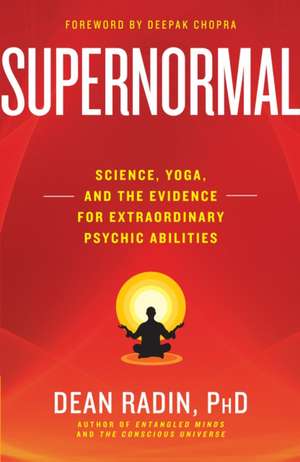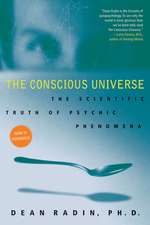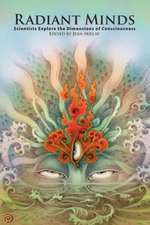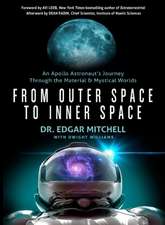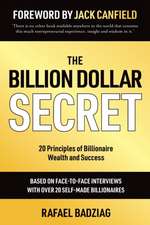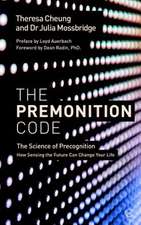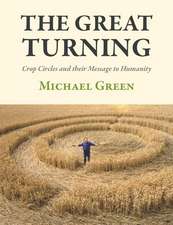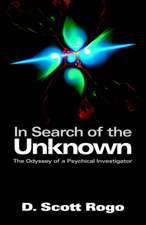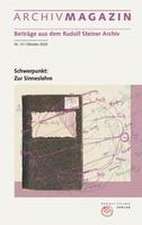Supernormal: Bestsellers Puteri şi fenomene paranormale
Autor Dean Radinen Limba Engleză Paperback – 15 iul 2013
Dean Radin, Director of Research at the Institute of Noetic Sciences (IONS) and bestselling author of The Conscious Universe, presents persuasive new experimental evidence for the existence of such phenomena. He takes us on a thrilling scientific journey and challenges outdated assumptions that these abilities are mere superstition. Focusing on Patanjali's mysterious Yoga Sutras -- 2,000 year-old meditation practices believed to release our extraordinary powers -- Radin offers powerful evidence confirming that sometimes fact is much stranger, spookier, and more wonderful than the wildest fiction.
Preț: 79.66 lei
Preț vechi: 95.12 lei
-16% Nou
15.24€ • 15.86$ • 12.59£
Carte disponibilă
Livrare economică 24-31 martie
Livrare express 08-14 martie pentru 38.46 lei
Specificații
ISBN-10: 030798690X
Pagini: 369
Ilustrații: 22 Line Art and 16 Photographs
Dimensiuni: 130 x 198 x 25 mm
Greutate: 0.32 kg
Editura: BALLANTINE BOOKS
Seria Bestsellers Puteri şi fenomene paranormale
Notă biografică
Dean Radin, PhD, is the author of Entangled Minds and The Conscious Universe. For more than two decades he has been engaged in research on the frontiers of consciousness. He has held appointments at Princeton University and several Silicon Valley think tanks, including SRI International, where he worked on a classified program investigating psychic phenomena for the US government.
Extras
Introduction
Begin at the beginning and go on till you come to the end; then stop.
--Lewis Carroll
We begin with a simple question: Was Buddha just a nice guy?
Did Buddha’s teachings thrive because he was more attractive or charismatic than most, or because he was a great teacher and a tireless advocate of the poor? Or--and here’s the core question we’ll explore in detail--was it also because he was an enlightened being with profound insights into the nature of Reality, and because he possessed supernormal abilities?
We might ask the same questions about Jesus, Moses, Mohammed, Milarepa, or a host of other historically prominent figures associated with special illumination, wisdom, or grace. Did these people just sport great tans and know how to work a crowd, or did they understand something genuinely deep about the human condition, and our capacities, that is not yet within the purview of science?
If it’s too touchy to ask such questions about religious icons, then we may consider a more contemporary figure: The Dalai Lama regularly hosts discussions between scientists and Buddhist monks. Do the Western scientists who compete for a coveted slot at those meetings secretly believe that he’s a backward country bumpkin, and they’re just humoring him long enough to get their photo taken with a famous Nobel laureate so they can post it on their Facebook page?
Given the glowing praise about those meetings in books and articles authored by no-nonsense science journalists, and a growing list of collaborators hailing from Harvard University, Stanford University, the University of Zurich, the Max Planck Institute for Human Cognitive and Brain Sciences, and many others, it doesn’t seem so. But the Dalai Lama takes reincarnation and the legendary yogic superpowers (the siddhis) seriously. He’s claimed to see some of them in action, like oracles who accurately divine future tendencies.6 What does he know that most Western-trained scientists studiously ignore? Could the superpowers actually be real? If so, why haven’t we read about them in science magazines?
Such questions have been debated by scholars and by ordinary people for millennia. In modern times, for the most part science has ignored or denigrated the mere possibility of superpowers because such abilities are not easily accommodated by Western scientific assumptions about the capacities of the human mind. It is also sidestepped because any answer offered is guaranteed to seriously annoy someone. If you say yes, “Buddha was just a nice guy,” then Buddhists will hurl epithets at you. They may do this in a kind and compassionate way, but you will still have to duck. If you say no, “Buddha was something more,” then you will have to dodge objects thrown with equal gusto by both scientists and devotees of other religions. As a result, for the sake of safety the question is usually left unanswered.
There will always be some who are not satisfied with this soft deflection. Cynics feel intense discomfort when questions are raised about the possibility of “something more.” They shout accusations of voodoo science, and they form posses to stop what they regard as ominous tides of irrationality from heading our way.7 Their concerns, bristling on the edge of hysteria, are not without justification. The promise of something secretly powerful, beyond the mundane, has been responsible for untold scams, conspiracies, and witch hunts throughout history. Civilization embraces superstitions and ignores rationality at its peril, so a legitimate case can be made that strenuous protection of hard-won knowledge is necessary.
But here’s the rub: It is precisely because civilization must advance beyond superstition that we are obliged to carefully explore our inquiry about the existence of supernormal abilities. The answer is relevant to basic scientific assumptions about the nature of human potential, to the relationships among science, religion, and society, and without hyperbole, to the likelihood that humankind will continue to survive.
In addition, all the nervous fussing one hears about the need to combat superstition, the wringing of hands about looming threats to rationality--such behavior positively drips with emotion, and that presents its own cause for concern. As British psychiatrist Anthony Storr wrote in Feet of Clay: A Study of Gurus, “Whether a belief is considered to be a delusion or not depends partly upon the intensity with which it is defended, and partly upon the numbers of people subscribing to it”(p. 199).8 When it comes to the possibility of superpowers, many are energetically engaged in either strident offenses or frenzied defenses, adding precious little reason to the debate.
But something new can now be brought to the discussion: empirical evidence. Laboratory data amassed over many decades suggest that some of what the yogis, mystics, saints, and shaman have claimed is probably right. And that means some of today’s scientific assumptions are probably wrong.
If you can’t stomach the thought that what you’ve learned in school might not be completely correct (in spite of the fact that textbooks are regularly revised), then rest assured: This does not mean that all the textbooks must be thrown away. Sizable portions of the existing scientific worldview are quite stable and will remain accurate enough for all practical purposes for a long time.
But it does mean that some of our assumptions, including a few fundamental ideas about who we are and the way the world works, are in need of revision. The newly developing worldview suggests, for example, that it is no longer tenable to imagine that the universe is a mindless clockwork mechanism. Something else seems to be going on, something involving the mind and consciousness in important ways.
After reviewing a substantial body of scientific evidence demonstrating that yoga can significantly improve physical health, New York Times journalist William Broad wrote in The Science of Yoga:
While the science of yoga may be demonstrably true--while its findings may be revelatory and may show popular declarations to be false or misleading--the field by nature fails utterly at producing a complete story. Many of yoga’s truths surely go beyond the truths of science. Yoga may see further, and its advanced practitioners, for all I know, may frolic in fields of consciousness and spirituality of which science knows nothing. Or maybe it’s all delusional nonsense. I have no idea.9 (p. 222)
Does science really know nothing about the more exotic claims of yoga? By the end of this book we’ll have discovered that Broad didn’t dig deep enough. We actually do know a few things.
Escape to Reality
Many ancient teachings tell us that we have the capacity to gain extraordinary powers through grit or grace. Techniques used to achieve these supernormal abilities, known as siddhis in the yoga tradition (from the Sanskrit, meaning “perfection”2, 5), include meditation, ecstatic dancing, drumming, praying, chanting, sexual practices, fasting, or ingesting psychedelic plants and mushrooms. In modern times, techniques also include participation in extreme sports, floating in isolation tanks, use of transcranial magnetic or electrical stimulation, listening to binaural-beat audio tones, and neurofeedback.
Most of these techniques are ways of transcending the mundane. Those who yearn to escape from suffering or boredom may dive into a cornucopia of sedatives and narcotics. Others, drawn to the promise of a more meaningful reality, or a healthier mind and body, are attracted to yoga, meditation, or other mind-expanding or mind-body integrating techniques.
Transformative techniques are potent, and like any power they are seductive and rife with pitfalls. Yoga injuries can occur when enthusiasm overcomes common sense.9 Meditation can lead to extreme introversion, depression, or spiritual hedonism.10 But the human need to transcend the humdrum is formidable and easily overrides caution. We see this in two of the more popular transformational techniques available today--alcohol and tobacco. These two mind-altering substances are tightly integrated into the economic engines of the modern world. The average household in the United States spends more just on tobacco products and its paraphernalia than on fresh fruit and milk combined, and more on alcohol than on all other nonalcoholic beverages combined.11
The World Health Organization estimated that in 2007 the societal cost of alcohol-related diseases, accidents, and violence was over $200 billion a year in the United States alone.12 The purchase cost of alcohol was even greater, estimated at nearly $400 billion a year in 2008.13 There is a similar statistic for tobacco.14 The formidable human desire to escape, just considering these two products alone, costs society trillions of dollars a year. If we included the costs associated with the use and abuse of stimulants and recreational drugs, gambling, and the entertainment industry, the total expense is staggering, a sizable proportion of the world’s economy. Humanity seems desperate to escape.
With banks and stock markets teetering at the edge of an apocalypse during the second decade of the twenty-first century, escaping outward has become too risky and too expensive for most people. What about escaping inward? Rarified minds tell us that they have seen something beautiful and glittering in our depths, something that promises a dramatic advancement in human potential. After seriously setting out on that path, most esoteric traditions say that we will eventually encounter genuine extraordinary phenomena, including the acquisition of supernormal powers.4
Yoga Superpowers
Classic yoga texts, such as Patanjali’s Yoga Sutras, written about two thousand years ago, tell us in matter-of-fact terms that if you sit quietly, pay close attention to your mind, and practice this diligently, then you will gain supernormal powers.15ߝ19 These advanced capacities are not regarded as magical; they’re ordinary capacities that everyone possesses. We’re just too distracted most of the time to be able to access them reliably.
The sage Patanjali also tells us that these siddhis can be obtained by ingesting certain drugs, through contemplation of sacred symbols, repetition of mantras, ascetic practices, or through a fortuitous birth. In the yogic tradition, powers gained through use of mantras, amulets, or drugs are not regarded with as much respect, or considered to be as permanent, as those earned through dedicated meditative practice.5
The promise of these superpowers has little to do with traditional religious faith, divine intervention, or supernatural miracles. As Buddhist scholar Alan Wallace says,
In Buddhism, these are not miracles in the sense of being supernatural events, any more than the discovery and amazing uses of lasers are miraculous--however they may appear to those ignorant of the nature and potentials of light. Such contemplatives claim to have realized the nature and potentials of consciousness far beyond anything known in contemporary science. What may appear supernatural to a scientist or a layperson may seem perfectly natural to an advanced contemplative, much as certain technological advances may appear miraculous to a contemplative.20 (p. 103)
Yogic wisdom describes many variations of the siddhis. Today we’d associate the elementary siddhis with garden-variety psychic phenomena. They include telepathy (mind-to-mind communication); clairvoyance (gaining information about distant or hidden objects beyond the reach of the ordinary senses); precognition (clairvoyance through time), and psychokinesis (direct influence of matter by mind, also known as PK).
For most people, psychic abilities manifest spontaneously and are rarely under conscious control. The experiences tend to be sporadic and fragmentary, and the most dramatic cases occur mainly during periods of extreme motivation. By contrast, the siddhis are said to be highly reliable and under complete conscious control; as such they could be interpreted as exceedingly refined, well-cultivated forms of psychic phenomena.
The more advanced siddhis are said to include invisibility, levitation, invulnerability, and superstrength, abilities often associated with comic book superheroes. All these abilities are also described in one form or another in shamanism and in the mystical teachings of religions. In fact, most cultures throughout history have taken for granted that superpowers are real, albeit rare, and surveys today continue to show that the majority of the world’s population still firmly believes in one or more of these capacities.21
Mainstream science is not so sure. Many scientists and scholars trained within the Western worldview regard such powers not as supernormal capacities of the human mind, but as superstitions used solely to promote religious faith.22
Who’s Right?
Who’s more likely to be correct about the siddhis--the world’s wisdom traditions or today’s scientific orthodoxy? We will explore this question not by recitation of amazing stories, or by analysis of religious arguments, or by examination of case reports (although we will look at a few). Rather, we’ll concentrate on controlled experimental evidence published in peer-reviewed scientific journals.
We will find that the scientific method is so powerful in discerning fact from fiction that a strong argument can be made in favor of some genuine siddhis. This is an example where scientific evidence trumps previously held assumptions, and it’s also a demonstration of the power of science to pull itself up by its bootstraps and to change from within.
This is not to say that this evidence has been warmly embraced. All organized holders of knowledge, whether in scientific or religious contexts, strenuously resist change. We will explore this resistance as well, as it will help us understand why we are only vaguely aware of our true potentials.
2. Radin D. Entangled Minds. New York: Simon & Schuster; 2006.
4. Murphy M. The Future of the Body: Explorations into the Further Evolution of Human Nature. New York: Tarcher (Penguin); 1993.
5. Jacobsen KA. Yoga powers and religious traditions. In: Jacobsen KA, ed. Yoga Powers: Extraordinary Capacities Attained Through Meditation and Concentration. Leiden, The Netherlands: Koninklijke Brill; 2012.
6. Lama D. Freedom in Exile: The Autobiography of the Dalai Lama. San Francisco: HarperOne; 1990.
7. Gross PR, Levitt N, Lewis MW, eds. The Flight from Science and Reason. New York: New York Academy of Sciences; 1996. Annals of the New York Academy of Sciences; No. 775.
8. Clay A. Feet of Clay: A Study of Gurus. New York: Free Press Paperbacks, 1996.
9. Broad WJ. The Science of Yoga. New York: Simon & Schuster,; 2012.
10. Criswell E. How Yoga Works: An Introduction to Somatic Yoga. Novato, CA: Freeperson Press; 1989.
11. McIntyre D, Sauter M, Stockdale C. Top 10 things Americans waste the most money on. 2011; http://www.topstockanalysts.com/index.php/2011/02/28/top-10-things-americans-waste-the-most-money‑on/, accessed February 18, 2012.
12. World Health Organization. Global Status Report on Alcohol and Health. 20 Avenue Appia, 1211 Geneva 27, Switzerland: WHO Press, World Health Organization; 2011.
13. Distilled Spirits Council of the United States. Economic Contributions of the Distilled Spirits Industry; http://www.discus.org/economics/, accessed February 18, 2012.
14. Guilfoyle J. Campaign for TobaccoFree Kids. September 16, 2011; http://www.tobaccofreekids.org/, accessed February 18, 2012.
15. Bharati SV. Yoga Sutras of Patajali. Vol II. Delhi: Motilal Banarsidass; 2001.
16. Desai YA. Amrit Yoga and the Yoga Sutras. Rhinebeck, NY: Red Elixir; 2010.
17. Satchidananda SS. The Yoga Sutras of Patanjali. 16th printing ed. Yogaville, VA: Integral Yoga Publications; 2011.
18. Simon D. The Yoga Sutras of Patanjali As-It-Is: Introduction, Commentaries, and Translation. 2011; http://www.rainbowbody.net/HeartMind/Yogasutra.htm., accessed May 18, 2011.
19. Shearer A. Effortless Being: The Yoga Sutras of Pantanjali. London: Wildwood House Limited; 1982.
20. Wallace BA. Hidden Dimensions: The Unification of Physics and Consciousness. New York: Columbia University Press; 2007.
21. Haraldsson E. Representative national surveys of psychic phenomena: Iceland, Great Britain, Sweden, USA and Gallup’s multinational survey. J Soc Psych Res. 1985;53(801):145-158.
22. Martin DB. Inventing Superstition: From the Hippocratics to the Christians. Cambridge MA: Harvard University Press; 2004.
Recenzii
"In the last 50 years, major discoveries in modern science increasingly support the wisdom and vision of the ancient philosophers and sages. Dean Radin’s work is a major step in the same context, showing us how the statements made by the ancient sages like Patanjali are supported by the current research conducted with strictest scientific protocols. Radin’s work seems to bear even greater promise of what is yet to come." --Swami Veda Bharati, D. Lit.
“Great advances in science are made by following the evidence, wherever it may lead. Adhering to this principle, internationally-known researcher and author Dean Radin convincingly demonstrates that psi phenomena invalidate the assumptions associated with the obsolete materialist worldview. Recognizing the fundamental aspect of mind and consciousness, Dr. Radin also explains why it is now time to significantly revise and expand our concepts about who we are and the ultimate nature of reality.” --Mario Beauregard, author of The Spiritual Brain and Brain Wars
"As with Dr. Radin’s previous work, this book is thoroughly researched, clearly written, and immensely engaging. Once again he has pushed the boundaries of religion, science, psychology, and philosophy. Invaluable reading!" --Michael Bloch, University of San Francisco
"Dean Radin is a modern-day Galileo of psychical research. He is an impeccable scholar and premier experimental scientist, and this is a terrific book. Come, look through his telescope; with great clarity, he goes right to the core of the most profound issues in the contemporary science of mind. By including a detailed review of a variety of experimental findings, this book presents in one easily accessible place a wealth of information, creating a valuable reference and teaching/learning resource for students and scholars alike. And by connecting all this with contemplative investigations of the nature of mind carried out over the course of millennia, this book makes an invaluable contribution to expanding the modern dialogue between science and the contemplative traditions." --David E. Presti, University of California, Berkeley
“In Supernormal, Dean Radin skillfully weaves threads of Eastern praxis (yoga) and the results of Western psi experiments into a seamless and fascinating tapestry, one that portrays not merely who we are but what we might aspire to become.” --Daniel Sheehan
Descriere
Can yoga and meditation unleash our inherent supernormal mental powers, such as telepathy, clairvoyance, and precognition? Is it really possible to perceive another person's thoughts and intentions? Influence objects with our minds? Envision future events? And is it possible that some of the superpowers described in ancient legends, science fiction, and comic books are actually real, and patiently waiting for us behind the scenes? Are we now poised for an evolutionary trigger to pull the switch and release our full potentials?
Dean Radin, Director of Research at the Institute of Noetic Sciences (IONS) and bestselling author of The Conscious Universe, presents persuasive new experimental evidence for the existence of such phenomena. He takes us on a thrilling scientific journey and challenges outdated assumptions that these abilities are mere superstition. Focusing on Patanjali's mysterious Yoga Sutras -- 2,000 year-old meditation practices believed to release our extraordinary powers -- Radin offers powerful evidence confirming that sometimes fact is much stranger, spookier, and more wonderful than the wildest fiction.
